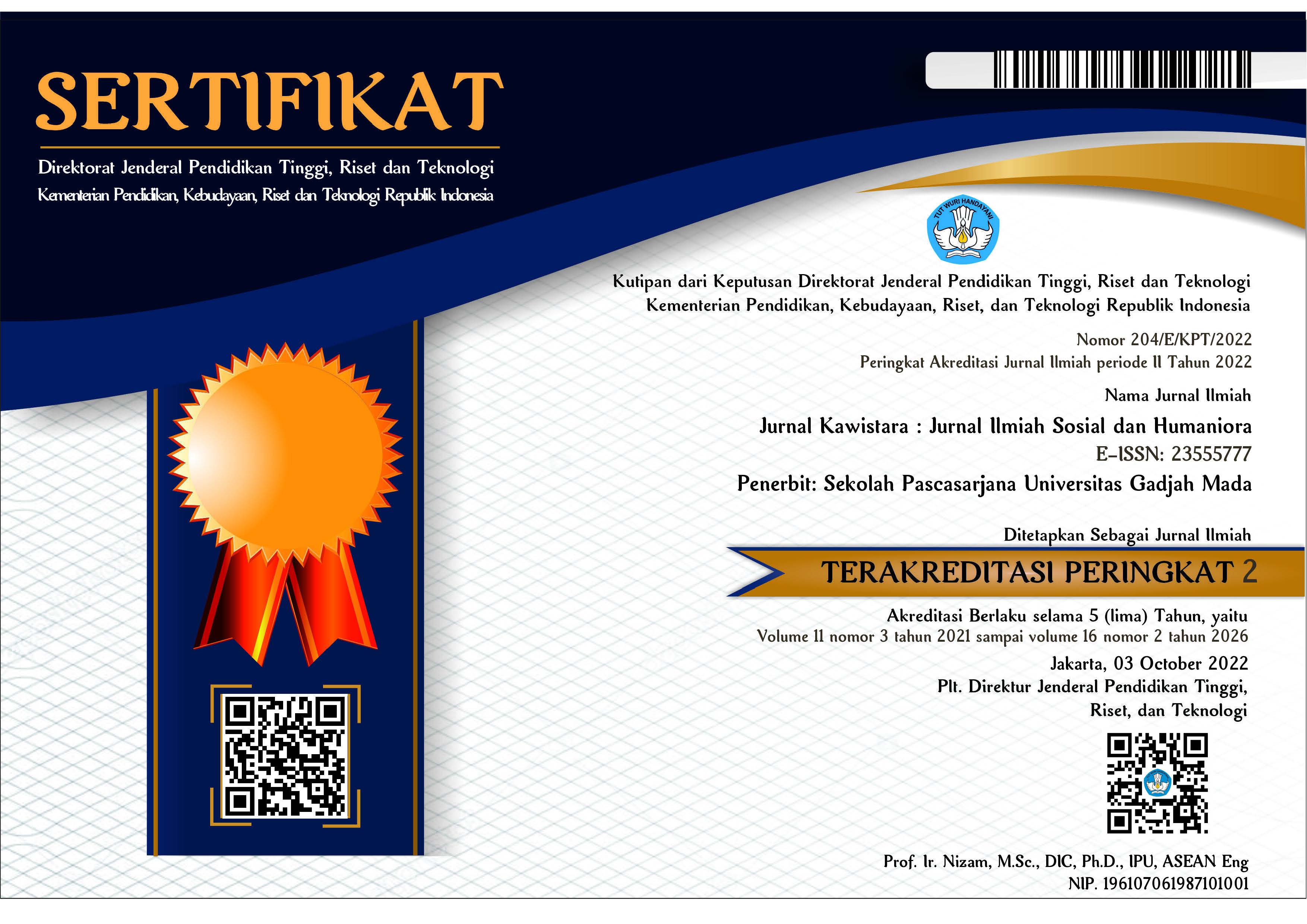BEYOND THE MONEY: A CASE STUDY ON THE BENEFIT OF HAND-DRAWING BATIK TO FEMALE BATIK WORKERS IN JARUM KLATEN REGENCY
Widhi Handayani(1*), Augustinus Ignatius Kristijanto(2), Arianti Ina Restiani Hunga(3)
(1) Universitas Kristen Satya Wacana
(2) Universitas Kristen Satya Wacana
(3) Universitas Kristen Satya Wacana
(*) Corresponding Author
Abstract
Keywords
Full Text:
PDFReferences
Ahmad, R., D. Amalia, M. Haggerty, B.P. Putra, I. Pratomo, E. Schlickman, and J. Taylor. 2010. Colored Water: Assessment of Climate Change Vulnerability in Kelurahan Pabean, Pekalongan, Central Java. Jakarta: Center for Participatory Development Planning Services UN Habitat.
Darmini. 2016. Interview.
Daryanti. 2016. interview.
Fajerman, M. 2014. Review of the Regulatory Framework for Homeworkers in Indonesia. Jakarta: International Labour Office.
Gaard, G. 1993. Living Interconnections with Animals and Nature. In Gaard, G (Ed.) Ecofeminism: Women, Animals, Nature. Philadephia: Temple University Press.
Handayani, W., A.I.R. Hunga, and A.I. Kristijanto. 2017. “Penetapan Skala Industri Batik Rumahan menurut Kriteria Lokal: Studi di Desa Jarum, Kabupaten Klaten”. Manajemen IKM 12 (1): 25-34.
Handayani, W., A.I. Kristijanto, and A.I.R. Hunga. 2018a. “Are Natural Dyes Eco-friendly? A case study on water usage and wastewater characteristics of batik production by natural dyes application”. Sustainable Water Resources Management.
_______. 2018b. “Behind the Eco-friendliness of Batik Warna Alam: Discovering the motives behind the production of eco-friendly batik in Jarum village, Klaten”. Wacana (in process of publication).
Harwanto, S. 2014. Kajian Wisata Seni Budaya Batik Berwawasan Lingkungan di Desa Jarum, Kecamatan Bayat, Kabupaten Klaten, Provinsi Jawa Tengah. Master Thesis, Yogyakarta: Institut Seni Indonesia.
Hunga, A.I.R. 2012. Menyingkap “Ketersembunyian” Home Workers dan Transformasi Putting Out System dalam Industri Mikro-Kecil-Menengah Batik: Studi kasus klaster industri batik di Sragen-Surakarta-Sukoharjo. Salatiga: Satya Wacana University Press.
Hunga, A.I.R. 2014. “Protecting Women‟s Domestic Area and Environment: Study on eco-friendly Batik”. Indonesian Feminist Journal 2: 82-105.
International Labour Office (ILO). 2015. Penelitian tentang Praktik Pengusaha dalam Mempekerjakan Pekerja Rumahan di Jawa Barat dan Jawa Tengah. <http://www.ilo.org/wcmsp5/groups/public/---asia/---ro-bangkok/---ilo-jakarta/documents/publication/wcms_438449.pdf>.
Kementerian Perdagangan Republik Indonesia. 2011. Miliki Potensi Ekonomi Tinggi, Mendag Serahkan Cetak Biru Pengembangan dan Pelestarian Batik ke Presiden. 28 September 2011. Press Release Pers Kementerian Perdagangan Republik Indonesia. Jakarta.
Kurniawan, M.W., P. Purwanto, and S. Sudarno. 2013. “Strategi Pengelolaan Air Limbah Sentra UMKM Batik yang Berkelanjutan di Kabupaten Sukoharjo”. Jurnal Ilmu Lingkungan 11(2): 62-72.
Kristijanto, A.I., W. Handayani, and P.A.A Levi. 2013. “The Effectiveness of Anaerobic Baffled Reactor and Rotating Biological Contactor in Batik Wastewater Treatment”. Makara Journal of Technology 15(2): 168-172.
Lucas, A. 2002. River Pollution and Political Action in Indonesia, in: Hirsch, P., & P. Warren (Eds.). Politics of Environment in Southeast Asia. New York: Routledge.
Marsinah. 2016. Interview.
Maslow, A. H. 1943. “A Theory of Human Motivation”. Psychological Review 50: 370-396.
Nakabayashi, M. 2017. “Honesty, Diligence, and Skill: Risk sharing and specialization in the Kiryu silk weaving cluster, Japan”. Review of Development Economics 21(4): 1401-1424.
Soebaryo, R.W. 2012. Batik Manufacturing Workers. In: Rustemeyer. T., P. Elsner, J. Swan-Malte, H.I. Maibach (Eds.) Kanerva’s Occupational Dermatology. Heidelberg: Springer Verlag.
UNEP. 2004. Women and The Environment. Nairobi: UNEP Publisher.
Article Metrics
Refbacks
- There are currently no refbacks.
Copyright (c) 2018 Widhi Handayani

This work is licensed under a Creative Commons Attribution-ShareAlike 4.0 International License.
Jurnal Kawistara is published by the Graduate School, Universitas Gadjah Mada.








